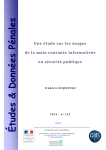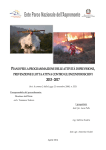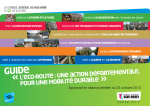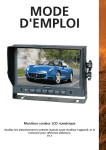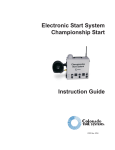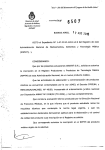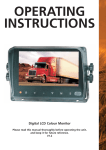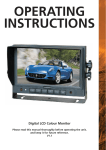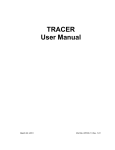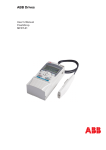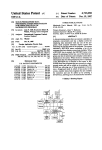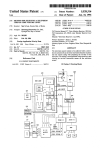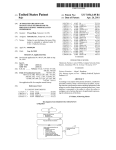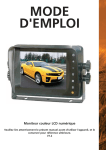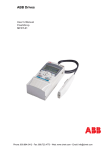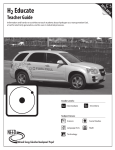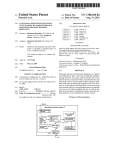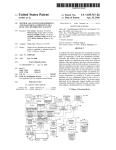Download lllllllllllllllllllllllllllllllllllllllllllllll|||l|lllllllllllllllllllllll
Transcript
lllllllllllllllllllllllllllllllllllllllllllllll|||l|lllllllllllllllllllllll USOO5577186A United States Patent [191 [11] Patent Number: Mann, II et al. [45] Date of Patent: [54] APPARATUS AND METHOD FOR PROVIDING A GENERIC COMPUTERIZED MULTIlVIEDIA TUTORIAL INTERFACE FOR TRAINING A USER ON MULTIPLE APPLICATIONS [76] 5,577,186 Nov. 19, 1996 Microsoft Works, Microsoft Corporation, 1989, pp. 7 and 30. Whitehom, PC User No. 221, pp. 42-44, Oct. 20, 1993 (abstract only). Inventors: S. Edward Mann, II, 11020 Huebner Oak #1136, San Antonio, Tex. 78230; Frederic Milliot, 5 Rue Boulle 75011, Paris, France Primary Examiner—Heather R. Herndon Assistant Examiner-Stephen Hong Attorney, Agent, or Firm~—Bruce E. Garlick [21] Appl. No.: 541,221 [57] [22] Filed: A computerized, multimedia tutorial interface system (10) Oct. 12, 1995 ABSTRACT and method for training a user to use computer application Related US. Application Data software. The system incorporates the training techniques of video segments, on-line tutorials, written instruction, and [63] Continuation of Ser. No. 283,618, Aug. 1, 1994. [51] [52] [58] Int. Cl.6 .................................................... .. G06F 9/455 US. Cl. ........................................... .. 395/806; 395/340 Field of Search ................................... .. 395/154-155, 395/133, 161, 153, 157; 434/118; 364/401 leaming-by-doing lessons. The system and method incor~ porate the video segments into the system so that they may be displayed on a computer screen (26). User input is given by way of a mouse (22), keyboard (30), or by voice through an audio interface (34). Once the video clip is displayed on a video window (55), the system preferably runs a set of [56] References Cited instructions within the computer application software to U.S. PATENT DOCUMENTS demonstrate the exact sequence of instructions that were 4,586,905 discussed in the video clip. Once this is completed, written 5/1986 Groff ..................................... .. 434/307 4,637,797 1/1987 Whitney et a1. . .. 434/118 4,701,130 10/1987 Whitney et al. . 434/118 4,772,206 4,798,543 5,237,648 9/1988 Kerr et al. ..... .. 1/1989 Spiece ............ .. 8/1993 Mills et al. .... .. 434/118 434/323 395/133 5,311,422 5/1994 5,388,993 2/1995 McKiel et al. Loftin et a1. .. . . . 5,448,739 9/1995 . . . . . .. 364/401 434/118 Jacobson ............................... .. 395/700 OTHER PUBLICATIONS instruction is provided and the user is then given an oppor tunity to execute the same functions as previously described and executed by the system. In this fashion, lesson content is multiply reinforced. The system may also include user monitoring to ensure that the user correctly enters the instructions as well as to monitor the progress the user is making in his or her training. Preferred applications of the system and method of the present invention include appli cation software, on-line services, and other complicated computer software systems. Staiti, Datamation vol. 39, No. 22, Nov. 15, 1993, p. 2 (abstract only). Microsoft Excel 5.0, Microsoft Corporation, 1994, Screen Printouts pp. 1—8. 12 Claims, 5 Drawing Sheets ' FILE EDITION AFFICHAGE STYLE SPECIAL OPTIONS INFO CHOOSE YOUR CLIP/LESSON =l| l / 53 57 )/ CONTENTS DISCOVEHING PAINTBRUSH'S MENUS, A DRAWING... CHANGlNG COLORS... / 55 ADDING TYPEDJN TEXT SAVING YOUR FILE BEFo'RE LEAVING. v # E] DURATION 14120 LEssoN [:E] E MAIN MENU i CLIP \ MIN SEC US. Patent Nov. 19, 1996 Sheet 2 of 5 5,577,186 5,577,186 1 2 APPARATUS AND METHOD FOR PROVIDING A GENERIC CONIPUTERIZED MULTIMEDIA TUTORIAL INTERFACE FOR TRAINING A USER ON MULTIPLE on-line tutorials were developed. On-line tutorials typically combined a written description of a particular function of the software and instruction in speci?c commands that would allow a user to perform the function. These on-line tutorials typically allowed a user to perform a few instructions at a APPLICATIONS time as directed by the tutorial with the instructions being monitored to ensure correctness of operation. While these This is a continuation of application Ser. No. 08/283,618, on-line tutorials provided the bene?t of learning while ?led Aug. 1, 1994. BACKGROUND OF THE INVENTION doing, they were typically di?icult to follow and did not 10 inadequate written explanation that canied over from the This invention relates to training users of computer soft ware. More particularly, this invention relates to a computer user’s manual was that such information was conveyed to the user only in a written format displayed on the screen. based system employing a multimedia approach to training users of various types of computer applications by providing audio\visual instruction along with on-line practice sessions using a multi-dimensional lesson monitoring approach. For many years application programs, on-line services, and other computer application software have been available for use with digital computers. Application programs per form word processing functions, numeric functions, data Further, because they were speci?c to the particular appli cation program, they did not provide a familiar reference frame for the user and the user ?rst had to learn to use the on-line tutorial in the particular program. Thus, attempts were made to combine the bene?ts of classroom training with the bene?ts of hands-on training on the user’ s own machine. A few vendors recorded classroom training programs on video cassettes so that a user could play the lessons at his or her own speed on a nearby base functions, accounting functions, inventory control functions, and a wide variety of other functions. Application programs serve not only to increase the e?iciency of the user but to increase the user’s accuracy as well. On-line services allow a user to access large databases of information. television while simultaneously working on the computer. 25 software or on-line service, a signi?cant amount of time is required to educate the user in the use of the computer application software or information services. Not until the user is su?iciently trained in the use of the computer application software or service may substantial bene?ts be derived from the program or service. The earliest approaches to training users were by the ing tools involved written instruction books that were included with the programs. These books described the functions available in the software, how to implement the functions, and the limitations of the functions. The earliest training books were written in a highly technical manner that prevented the average user from gaining a thorough under Thus, a user could combine the bene?ts of working on his or her own machine while also obtaining the bene?ts of being in a classroom. Unfortunately, there was no interplay between the video being viewed and the user’s commands issued to the computer application software. While this system allowed the user to play the video in his of her of?ce, it did not provide the interactive bene?ts available from other techniques. Thus, the system did not reinforce the commands described in the video and required the simulta However, when ?rst implementing the computer application providers of computer application software. The ?rst train provide adequate explanation. Part of the problem related to neous operation of two separate machines. A recent visual teaching aid, sold under the tradename 35 LOTUS SCREENCAM, displays images on a computer screen that are identical to those displayed within an appli cation program. However, even though the teaching aid to use the programs. Over time, with increased competition, the written materials became easier to read and understand, displays images that a user would encounter during use of the program, the teaching aid merely functions like a video player. The teaching aid merely displays to the user a proper sequence of keystrokes and/or mouse movements that would be required to execute speci?c functions and does not provide interaction between the user and the actual appli cation program. providing more thoughtful approaches to educating the user. While the software industry developed, some persons and SUMMARY OF THE INVENTION standing of the program. Resultantly, a large industry grew around providing written training materials for training users organizations recognized the shortcomings of the written book type instruction and stepped in to provide classroom and interpersonal instruction. Classroom type instruction targeted speci?c software that was popular enough to justify the large capital expenses associated with this type of training. Levels of instruction varied from lectures given in large auditoriums all the way down to one-on-one training sessions. While this type of instruction proved to be quite successful due to its human aspect, it was very expensive and generally required that the new user leave his or her place of employment to attend. Further, because the user generally was not provided with hands on training, and even 50 55 It is therefore a general object of the invention to over come the above described limitations, and others, of the prior tutorial devices and methods. More particularly, it is an object of the invention to provide a computer based tutorial interface system that provides a user with audio/visual training on speci?c functions of a computer program or computer service, provides actual samples of the implemen tation of the functions, assists the user in learning to perform the function within the computer application software, and requires the user to take an active approach in the training by performing actual instructions within the application soft if he or she was, the training was not performed on his or her own machine. Because of dilferences in machines and ware on the user’s own machine. environments used in the training classes, the user could not always transfer the knowledge he or she had obtained to his tutorial interface system for training a user to use a computer or her own computer. To accomplish these objects, a computerized, multimedia application comprises, generally, a user control interface, an audiovisual tutorial interface, and a computer application software interface. The system preferably takes the form of a software engine that performs all necessary control and Over time, vendors of the software and others in the 65 industry recognized the value of training the user on his or interface functions between the user, a video tutorial that is her own machine while inside the software itself. Thus, 5,577,186 3 4 displayed on the user’s computer screen, and the computer application software itself. In this fashion the interface tions will be used as a guide and compared to the user’s system allows a user to control the video tutorial, view an feedback to the user. execution of program functions, and practice performing the The system of the present invention may also include evaluation means that evaluates the instructions issued by instructions. In this fashion, the system provides immediate functions of the program itself. The system resides on the user’s machine so that the user may perform all of the functions at his or her leisure. In this manner, lessons learned the user and issue a summary of the user’s performance in will be imprinted fully. edge and pro?ciency may be gauged and reported. Further, Preferably, the system includes control display means, instruction input and interpretation means, audiovisual enablement means, and computer application software inter issuing the instructions. In this fashion, the user’s knowl 10 face and control means. The control display means displays a control window on a computer screen through which the training a user to use computer application software. The user may select any of a plurality of instructions using keyboard, mouse, or verbal input. As one option, the user views a video segment that describes a speci?c function of the computer application software. Preferably, the user may select these video segments on a chapter-by-chapter and steps of this method parallel those described above for use of the system. The method includes steps of providing a user with an audiovisual tutorial, executing certain program functions, and allowing a user to execute the described functions. These steps are carried out in a manner analogous to the use of the system described above. The method also lesson-by-lesson basis. Other functions include moving for ward, backward, or searching for a particular lesson, view includes additional instructions more fully described herein. The system and method of the present invention provide ing the execution of a sequence of instructions within the computer application software, and gaining control over the computer application software, among others. In this fash ion, the user can control the operation of the system as desired. Responsive to the user’s input, the instruction input and interpretation means receives the instruction and executes the respective command within the system. When a video play command is selected by the user, the the progress made by the user in his completion of the training may also be monitored. The present invention also comprises a computerized method for providing a multimedia tutorial interface for 25 many important advantages over the prior tutorial methods and systems. Among other advantages, the system of the present invention provides, in combination, the bene?ts of a plurality of techniques so that the bene?ts may compound and reinforce each other. The present invention provides a user controllable audiovisual tutorial program that displays audiovisual enablement means receives the execution visual information on the user’s own computer screen. instruction, retrieves the selected audiovisual information, Therefore, the user may selectively view any lesson in the tutorial without leaving his or her o?ice and machine. and displays the audiovisual information on at least a portion of a computer screen. Preferably, the audiovisual informa 30 After the video clip has been played, the system con?rms and enforces the lesson by demonstrating the function or tion comprises various pre-recorded tutorial video clips that describe a speci?c function or feature of the computer service feature that was described in the video clip. The application software. Preferably, these video clips are dis system demonstrates, step-by-step, the instructions required played on a window on the computer screen separate from 35 the control bar. However, at the user’s option, the window could be expanded or contracted to provide a larger or smaller viewing area. Preferably, after the video clip is displayed, the computer to perform the described function or service feature. There fore, the user is instructed exactly how to perform the function described in the video. Because these instructions are demonstrated as performed within the computer appli cation software itself, the environment is exact, and no application software interface means interfaces with the translation of techniques is required. computer application software and selectively executes the The system also allows the user to practice the commands that were described immediately after they were performed function described in the video segment so that the user may watch the particular functions that were described in the video clip execute within the computer application software. by the system. This reinforcement ensures that the user has 45 mastered the function described. Because the system and While the function that is executed will generally be the one method of the present invention combines the bene?ts of that was previously described in an video segment, the user varied other approaches it more effectively tutors the user. Further, because the program provides the same user inter may also request that a speci?c function within the computer application software be demonstrated without ?rst display ing the related video segment. After the user has been 50 educated on the function by the video segment, the software demonstrates how the function is executed within the pro gram. In this manner, the lesson has been reinforced and taught in a manner such that it may be duplicated by the user. Preferably, at this point, a synopsis and explanation of the 55 executed commands are provided to the user. After the system has demonstrated the computer applica reference. And, because the user operates the system com pletely from his or her own machine, training time is minimized. Further, individual retention of knowledge is maximized through the self-paced interaction with the par ticular software ‘or service provided by the system. Because the system of the present invention provides a generic interface to any computer application software, the system may be used to teach users of on-line services in the use of the services as well as many other computer appli tion software function to the user and provided the user with a synopsis, the computer application software control means selectively relinquishes control of the computer application face, independent of the computer application software it is teaching, it provides the user with a familiar point of 60 cations. Further, even though the system is generic, it could software to the user. The user may then perform the func even be embedded in a particular software program to tions that were previously described in the video clip and performed by the system. Preferably, in this portion of the provide a speci?c interface. Thus, the system has great ?exibility and adaptability in its application. operation, the system will monitor the instructions executed These and other objects, advantages, and features of the by the user and issue an error message to the user on the 65 invention will be apparent from the following description of computer screen if the user executes an instruction that is the preferred embodiments, considered along with the erroneous. Typically, a plurality of sets of “correct” instruc accompanying drawings. 5,577,186 6 5 The terms “application”, “computer application soft BRIEF DESCRIPTION OF THE DRAWINGS ware”, and “program” are used interchangeably herein to refer to any computer program run in conjunction with the FIG. 1 is a functional block diagram of a computer utilized in conjunction with the present invention. FIG. 2 is a functional block diagram showing the func tional relationship between the components of a system embodying the principles of the present invention. present inventive system. Such computer programs could relate to computer applications, with on-line services, com munication systems, or any other computer oriented func~ tion. FIG. 3 is a functional flow chart detailing the operation of the system of FIG. 2. FIGS. 4A and 4B are sample display screen view detailing a visual interface of the embodiment of the present invention disclosed in FIG. 2. The term “current” is sometimes used herein as an ante cedent to “window”, “application”, etc., and is used to denote system components which are currently being uti lized or performing operations with respect to a particular computer application software running in the environment. DESCRIPTION OF THE PREFERRED EMBODIMENTS ~ NOMENCLATURE AND DEFINITIONS The descriptions which follow are presented in part in terms of algorithms and symbolic representations of opera In the following description, certain details are set forth to tions within a computer. These descriptions and representa provide a complete understanding of the present invention. It will be apparent to one skilled in the art, however, that tions are the means used by those skilled in the software arts to most effectively convey the substance of their work to 20 these speci?c details are not required in order to practice the present invention. Also, well known electrical structures and others skilled in the art. circuits are depicted in block diagram form so as not to An algorithm is here, and generally, conceived to be a obscure the present invention unnecessarily. self-consistent sequence of steps leading to a desired result. These steps are those requiring physical manipulations of physical quantities. Usually, though not necessarily, these 25 quantities take the form of electrical or magnetic signals capable of being stored, transferred, combined, compared, and otherwise manipulated. It proves convenient at times, principally for reasons of common usage, to refer to these signals as, values, symbols, characters, display data, terms, numbers, or the like. It should be borne in mind, however, that all of these and similar terms are to be associated with the appropriate physical quantities and are merely used here as convenient labels applied to these quantities. Further, the manipulations performed are often referred to in terms, such as comparing, commonly associated with mental operations performed by a human operator. No such capability of a human operator is necessary, or desirable in most cases, in any of the operations described herein which 35 A system 10 embodying the principles of the present invention is shown by way of illustration in FIGS. 1-4. The system 10 of the present invention is implemented on a typical computer system 11 as shown in FIG. 1. This computer system 11 typically comprises a CPU 12, a com puter bus 14, a disc drive 16, main memory 18, a compact disc drive 20, and user interface components. These user interface components preferably comprise a mouse 22 and mouse controller 24, a video display 26 and video display controller 28, and a keyboard 30 and keyboard controller 32. Preferably, the computer system 11 also includes an audio interface 34 that transmits audio information to and receives audio information from a user of the system. As one skilled in the art will appreciate, the system and method of the present invention are implemented on the computer system 11 but are not readily identi?able as form part of the present invention, since the operations are machine operations. Useful machines for performing the operations of the present invention include general purpose digital computers or other similar devices. The present invention relates to method steps and apparatus for operating a computer in processing electrical or other physical signals to generate other desired physical signals. speci?c components of the system. Those skilled in the art will readily understand how the described invention may be implemented on any of a variety of computer systems. Therefore, the implementation of the system on a particular hardware platform will not be more fully described herein. Referring now to FIGS. 2 through 4, a computerized, The present invention also relates to a system for per use computer application software comprises control display means 40, instruction input means 42, instruction interpre— forming these operations. This system may be speci?cally multimedia tutorial interface system 10 for training a user to constructed for the required purposes or it may comprise a 50 tation means 44, audiovisual enablement means 46, com‘ puter application software interface means 48, and computer general purpose computer as selectively activated or recon application software control means 50. ?gured by a computer program stored in the computer. The algorithms presented herein are not inherently related to any Referring speci?cally to FIGS. 2 and 3, the control particular computer or other apparatus. In particular, various display means 40 comprises a control bar 51 and a chapter/ general purpose machines may be used with programs 55 lesson selection screen 53, each of which are selectively written in accordance with the teachings herein, or it may displayed on the computer screen 26. Together, the control prove more convenient to construct more specialized appa bar 51 and the chapter/lesson selection screen 53 provide a ratus to perform the required method steps. The required plurality of instructions to a user that may be selected by the structure for a variety of these machines will appear from the user. As is shown, the control bar 51 preferably has com description below. mands similar to those found on a video tape player, In the following description, several terms are used fre including exit, rewind, goto, fast forward, stop, back, pause, and play. The chapter/lesson selection screen 53 allows a quently, have specialized meanings in the present context, user to access video segments relating to speci?c lessons to and are thus de?ned. The terms “environment”, “windowing be learned. Typically the user accesses speci?c video seg environment” and “running in windows” are used inter changeably to denote a computer user interface in which 65 ments on a chapter-by-chapter and lesson-by'lesson basis as information is manipulated and displayed within bounded desired. In the preferred embodiment, the chapter/lesson regions on a raster scanned video display. selection screen 53 is displayed only when certain com 5,577,186 7 8 mands are executed via the control bar 51. However, interpretation means 44. The computer application software interface means 48 interfaces directly with computer appli depending upon the application, the chapter/lesson selection screen 53 could also be continuously displayed cation software and selectively executes a function of the computer application software that is described in a video The instruction input means 42 operates to receive an instruction from a user 49. Preferably, the instruction input means 42 combines hardware and software components. In clip. Thus, the functions performed by the computer appli cation software interface means 48 within the computer application software provides a second visual training tool to the user 49 on the computer display 26. Preferably, the function or set of functions executed within the computer the preferred embodiment of the present invention, the instruction input means 42 comprises the combination of the mouse 22, the keyboard 30, the control bar 51, the chapter/ lesson selection screen 53, and related software that allows 10 the user 49 to select a desired function. Selecting a command from a menu displayed on a computer screen 26 using a mouse 22 and via a keyboard 30 are both well known in the art and are not fully described herein. As one skilled in the application software relate directly to the audiovisual seg ment that was just displayed to the user 49. Preferably, the computer application software interface means 48 comprises a dynamic link library (DLL) interface communication agent art will readily appreciate, however, the instruction input means 42 could also include the combination of the audio 4 interface 34 in conjunction with voice recognition software. The instruction interpretation means 44 interprets the user instruction, creates at least one execution instruction, and that is loaded into main memory at system 10 startup. The DLL interface communication agent accesses instruction sets speci?c to the computer application software of interest that are stored in separate ?les on the disc drive 16. Thus, to perform a speci?c set of instructions within the computer application software, the DLL interface communication agent brings the computer application software up on the computer display 26, accesses the instructions, and then executes the instructions within the computer application program. The computer application software control means 50 selectively issues the execution instruction. The instruction interpretation means 44 preferably comprises a series of software instructions executed on the computer system 11 in a fashion well known in the art. For example, when the user selects an instruction via the instruction input means 42, selectively relinquishes control of the computer application software code monitors the mouse controller 24 and key 25 software to the user 49 so that the user may practice board controller 32 interfaces, receives input from the inter faces, processes the input to determine what function has operating the computer application software. The computer been executed, and issues the proper execution instruction to regains control of the computer application software from application software control means 50 also selectively the respective system component. the user 59. In this fashion, the user may practice those techniques that were previously described to him via the Still referring to FIGS. 2 and 3, the audiovisual enable ment means 46 operates to receive execution instructions video clip and also were performed by the computer appli from the instruction input means 44, to selectively retrieve cation software interface means 48. As one skilled in the art audiovisual information responsive to the execution instruc will readily appreciate, the computer application software tion, and to display the audiovisual information on the 35 control means 50 is preferably implemented as a combina computer screen 26. Preferably, the audiovisual information tion of software instructions. comprises a video clip that is retrieved from a compact disc Preferably, the system 10 of the present invention also via the CD drive 20. The video clip is then decoded, comprises user instruction monitoring means 52, error mes formatted, and displayed on the computer screen 26 in a sage issuance means 54, and evaluation means 56, all of video window 55. The video window 55 may cover only a which provide feedback to the user when the user has control portion of the computer screen 26 or may be expanded to be of the computer application software. Speci?cally, the as large as the screen. Preferably, as is shown in FIG. 3, the instruction monitoring means 52 monitors the user instruc video window 55, the control bar 51, and the chapter/lesson selection screen 53 all reside on top of the computer appli cation software window 57 when they are active. However, when they are inactive, they are all hidden. Further, in the preferred embodiment the chapter/lesson selection screen 53 is displayed only when certain user instructions are executed. tions issued to the computer application software, keeping track of the instructions. When activated, the error message 45 issuance means 54 issues an error message to the user on the computer screen 26 if the user issues instructions that are erroneous. To determine whether the issued instructions are erroneous, the error message issuance means 54 compares the user’s issued instructions to a list of correct instructions. In a typical use of the tutorial interface system, the user 50 Further, when activated, the evaluation means 56 evaluates 49 selects a speci?c video clip that corresponds to a par ticular chapter and lesson to be learned. The video clip is then retrieved and displayed on the computer screen 26 in the video window 55. After the information has been dis played, and if the process has not been aborted or otherwise interrupted by the user, control may be returned to the user or be given to another system 10 component. In the preferred the instructions issued to the computer application software by the user and issues a summary of the user’s performance in issuing the instructions. Thereby, the evaluation means 56 provides an indication of the user’s performance in learning 55 embodiment, immediately after the video clip has been displayed, or during a user 49 initiated break in the video clip, control is taken again by the computer application 60 software interface means 48. However, the system 10 may also be operated such that the computer application software interface means 48 takes control during a video clip, halts the video clip to demonstrate a function or service feature, and then later restarts the video clip. 65 The computer application software interface means 48 also receives execution instructions from the instruction to use the computer application software. As one skilled in the art will readily appreciate, the user instruction monitor ing means 52, error message issuance means 54, and evalu ation means 56 are all preferably implemented as a combi nation of software instructions and executed accordingly. Referring speci?cally to FIG. 4, the operation of the tutorial interface system 10 is described. In the description of the system 10 operation, each relevant system event is identi?ed with a numeral in parentheses. Immediately after the system 10 is started (100), the interface with the com puter application software is initiated and the control bar 51 and video window 55 are created (102). Next, the interface between the main program and the DLL is established (104) 5,577,186 9 10 and the DLL interface communication agent is loaded into application software to enforce what he or she has learned main memory 18. At this point, the product logo is displayed (168). Then, the user’s performance is evaluated (170). and an introduction video segment may be played (108) on the computer screen 26. The system 10 then prompts the user to enter an instruction from the control bar 51. Immediately upon entering the program a chapter index is set to a The COUNTER INFO instruction (172) toggles the time information displayed between elapsed time from the start of the video clip to the time remaining in the video clip (174). Optionally, the counter could also display the time since the predetermined value and a lesson index is also set to a predetermined value. When the program is run for the ?rst time, these two indexes are set at one. However, when the user 49 logged on or the clock time. The counter hide user 49 continues with a previously started lesson, the indexes may be automatically set to those of the prior session. Each instruction available on the control bar 51 may be executed by the user 49. The EXIT instruction (110) pro vides noti?cation of an exit to the DLL via the DLL instruction (176) toggles the counter display between being 10 communication agent (112), stops the DLL communication agent (114), and closes all DLL command ?les (116). The hidden or displayed (178). The system 10 of the present invention can be easily implemented with application programs, on-line services, or any computer application software. The system 10 is generic and provides a familiar training interface that can be used in many varied situations. As one skilled in the art will readily appreciate, the system 10 of the present invention is readily transportable to provide tutorial instruction in any computer based system. The present invention also includes a computerized, mul EXIT instruction (110) further shuts down the core program timedia tutorial interface method for training a user to use (118), closes the control bar 51 window, the chapter/lesson selection screen window 53, and the video window 55 (120), 20 computer application software. The method is analogous to the previously described system and is not described to the same extent. With reference to the FIGURES, the method of the present invention comprises as a ?rst step displaying a and ends the training session (122). Executing the REWIND (RWD) instruction (124) with a double click causes the current lesson index and the current control window 51 and 53 on a computer screen 26. As chapter index, as displayed in the chapter/lesson selection screen window 53, to index to the ?rst chapter and ?rst 25 lesson (126). Executing the REWIND (RWD) instruction with a single click causes the current chapter index to A next step is receiving a user instruction from a user 49. Once the instruction is received the steps of interpreting the user instruction to creating an execution instruction are lesson selection screen 53 and allows the user to select a plays (130). received. Once created, the steps of issuing the execution instruction and receiving the execution instruction are per formed. Responsive to the execution instruction, one of three 35 Executing the FAST FORWARD (FF) instruction (132) with a double click causes the current lesson index and the And a third step is selectively executing a function of the computer application software that is described in the audio visual information. selection screen window 53, to index to the last chapter and last lesson (134). Executing the FAST FORWARD (FF) instruction (132) with a single click causes the current A ?rrther step is selectively relinquishing control of chapter index to increment by a single chapter (134). computer application software to a user. This allows the user to practice the skills he has learned. A ?nal step includes 45 immediately (138). Executing the BACK instruction (140) The method of the present invention also preferably previously viewed video clip again (142). The PAUSE instruction (144) causes the currently playing video clip, if includes the steps of monitoring user instructions issued to computer application software by a user. Another additional step is issuing an error message to a user on a computer screen if a user issues an instruction to computer application software that is erroneous as compared to a list of correct 55 the DLL library and executed within the computer applica tion software (160). Once the instructions are completed, a backwards noti?cation is sent (162) so that the control bar 51 _ and the video window 55 are again displayed (164). Next, a short, written synopsis of the demonstration that was executed is displayed to the user 49 on the computer screen 65 26 (168). Then, the computer application software interface means 48 allows the user to practice within the computer selectively regaining control of the computer application software from the user. freezes the current chapter and lesson indexes and plays the one is playing, to stop for later continuation (146). The PLAY instruction (148) ?rst causes the chapter counter to increment (150). The chapter counter indexes the relevant video clip and DLL instructions. The next video clip is then played in the video window 55 (152). Then, the control bar 51 and the video window 55 are hidden and the DLL instructions may be executed (154). A noti?cation of play is transmitted to the DLL interface communication agent (156), the order is received by the DLL interface communication agent (158), and instructions are read from separate steps is performed. A ?rst step is selectively retriev ing audiovisual information responsive to the execution instruction. A second step is displaying the audiovisual information on at least a portion of a computer screen 26. current chapter index, as displayed in the chapter/lesson Executing the STOP instruction (136) causes the process that is running when the instruction is executed to stop ity of instructions to a user 49 that may be selected by the user. decrement by a single chapter (126). Executing the GOTO instruction (128) opens the chapter/ particular chapter and lesson to be indexed (130). Then the user 49 has the option of playing the video clip or the demonstration of the particular lesson. Depending upon the option selected, the video clip plays or the demonstration previously described, the control window provides a plural~ instructions. Further additional steps are evaluating the instructions issued to computer application software by a user and issuing a summary of the user’s performance in issuing the instructions. As one skilled in the art will readily appreciate, the method of the present invention could be used in a wide variety of systems. Whenever training of a user is required, the method of the present invention could be employed. While speci?c applications of this method involve applica tion programs, the method could also be used with other computer based services such as on-line services. The above described preferred embodiments are intended to illustrate the principles of the invention, but not to limit the scope of the invention. Various other embodiments and 5,577,186 11 modi?cations to these preferred embodiments may be made by those skilled in the art without departing from the scope of the following claims. 1. A computerized, multimedia tutorial interface system for training a user to use any of a plurality of independently executable computer application software programs, the system comprising: (a) evaluation means for evaluating the user instructions issued to the instruction input means by a user and for issuing a summary of the user’s performance in issuing the user instructions. (a) computer application program selector, wherein the application that is erroneous as compared to expected instructions. 4. The computerized, multimedia training system of claim 1 further comprising: We claim: computer 12 issues a user instruction to the instruction input means 5. The computerized, multimedia training system of claim software program ~ selector 10 1 wherein the control display means comprises a display bar receives an instruction from a user and causes the having commands selected from a group of commands computerized, multimedia tutorial interface system to select a computer application software program from including at least exit, rewind, goto, fast forward, stop, back, pause, and play. 6. The computerized, multimedia training system of claim the plurality of independently executable computer application software programs; (b) control display means for displaying a control window on a computer screen, the control window providing a plurality of instructions to a user that may be selected by the user, wherein the instructions include instruc tions for displaying audiovisual images describing operations of the selected computer application soft ware program; (c) instruction input means for receiving a user instruction from a user; (d) instruction interpretation means for receiving the user instruction from the instruction input means, for inter preting the user instruction based upon the selected computer application software program to generate an 1 wherein the audiovisual information is displayed in a window on a computer screen adjacent to, and not overlying, the control window. 7. A computerized, multimedia tutorial interface method for training a user to use any of a plurality of independently executable computer application software programs, the method comprising the steps of: (a) displaying a list of the plurality of independently executable computer application software programs to a user; (b) receiving a software application program selection instruction from the user and, based upon the software execution instruction, and for selectively issuing the application program selection instruction, selecting an application software program from the plurality of execution instruction to element (e), (f) or (g) based independently executable computer application soft 30 upon the user instruction; (e) audiovisual enablement means for receiving an execu tion instruction from the instruction interpretation means, for selectively retrieving audiovisual informa tion responsive to the execution instruction, and for displaying the audiovisual information on at least a 35 portion of a computer screen, wherein the audiovisual information includes audiovisual images describing operations of the selected computer application soft ware program; (f) computer application software interface means for receiving an execution instruction from the instruction interpretation means, for interfacing with the selected computer application software program, and for issuing simulated user input to the selected computer applica ware programs; (c) displaying a control window on a computer screen, the control window providing a plurality of instructions to a user that may be selected by the user, wherein the instructions include instructions for displaying audio visual images describing operations of the selected computer application software program; ' (d) receiving a user instruction from a user; (e) based upon the selected computer application software program, interpreting the user instruction to generate an execution instruction; (f) based on the execution instruction and the selected computer application software program, selectively retrieving audiovisual information; tion program to execute a function of the selected (g) based on the execution instruction, displaying the computer application software program that is described in the audiovisual image; and (g) computer application software control means for audiovisual information on at least a portion of a receiving an execution instruction from the instruction interpretation means, for causing the computerized, multimedia tutorial interface system to completely relinquish control to the'computer application software program to allow a user to execute functions within the computer application software program, and for caus 55 ing the computerized, multimedia tutorial interface system to gain control from the computer application software program based upon user input. 2. The computerized, multimedia training system of claim 1 further comprising: (a) user instruction monitoring means for monitoring user instructions issued to the instruction input means by a user. 3. The computerized, multimedia training system of claim 2 further comprising: (a) error message issuance means for issuing an error message to a user on a computer screen if the user computer screen, wherein the audiovisual information includes audiovisual images describing operations of the selected computer application software program; (h) based on the execution instruction, executing a func-‘ tion of the computer application software program that is described in the audiovisual information by issuing simulated user input to the selected computer applica tion software program; (i) based on the execution instruction, completely relin quishing control to the selected computer application software program to allow a user to execute functions within the selected computer application software pro gram; and 6) based on user input, regaining control from the selected computer application software program. 8. The computerized, multimedia training method of 7 claim 7 further comprising the step of: (a) monitoring user instructions issued by a user. 9. The computerized, multimedia training method of claim 8 further comprising the step of: 5,577,186 14 13 (a) issuing an error message to a user on a computer commands selected from a group of commands including at screen if a user issues a user instruction that is errone— least exit, rewind, goto, fast forward, stop, back, pause, and ous as compared to reference user instructions. play. 10. The computerized, multimedia training method of claim 7 further comprising the steps of: (a) evaluating the user instructions issued by a user; and (b) based upon the user instructions issued by the user, issuing a summary of the user’s performance in issuing 12. The computerized, multimedia training method of claim 7 wherein in the step of displaying the audiovisual information on at least a portion of a computer screen, the audiovisual information is displayed in a window on a computer screen adjacent to, and not overlying, the control 11. The computerized, multimedia training method of 10 Window claim 7 wherein the step of displaying a control window on the user instructions. a computer screen includes displaying on a control bar













